Cities with large populations and vibrant economies produce large volumes of greenhouse gases (GHGs). Bangkok, one of the largest cities in Southeast Asia, is implementing various measures to deal with climate change in cooperation with JICA.
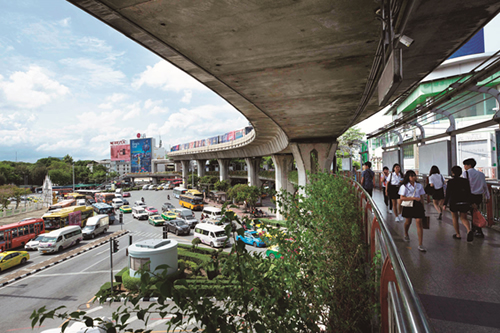
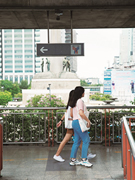
Many people use the Skywalk, which was constructed under an elevated railway to make the station directly accessible from the second and third floors of surrounding buildings.
Reducing urban traffic congestion
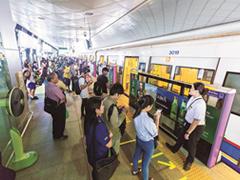
The MRT Blue line opened in 2004. On average, the Blue line and Purple line together transport 370,000 people per day.
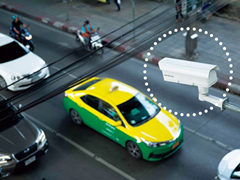
A camera monitors the number of passing vehicles. Trial tests to optimize traffic signals were conducted, which resulted in reduced traffic congestion.
Learning from Good Examples
The City of Yokohama:
A Forerunner in Combatting Global Warming
The City of Yokohama established the Climate Change Policy Headquarters (currently Coordination Division) in 2008, and has been making efforts to reduce GHGs, ahead of other cities in Japan. In addition to its traffic policies, the city has led the way in multiple areas: installation of LED street lights powered by solar panels; installation of solar panels and high-capacity lithium ion batteries at elementary schools that can be remotely managed to cut down the use of electricity during peak hours; and the introduction of virtual power plants that can take on the role of emergency power generators during disasters.
Kimihiro Kuromizu
Chief Advisor
Oversaw the development of Yokohama's transport network, including railways and expressways. Later on served as the first chief of the Global Warming Countermeasures section. He has been working as a JICA expert in Bangkok since May 2018.
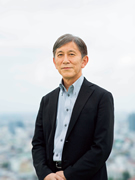
Climate Actions Make Cities More Attractive
"A large volume of GHGs [1] are produced by major cities with large populations and vibrant economies. If these cities can reduce GHG emissions, they can significantly contribute to the reduction of emissions in their respective countries. Moreover, combatting air pollution and traffic congestion increases the spatial value of the cities."
These are the views of Kimihiro Kuromizu, from Japan's second largest city, Yokohama. He has been dispatched to Bangkok as an expert in climate change strategy. Yokohama is one of the local governments that have been actively working on climate change issues. The city has a close relationship with the Bangkok Metropolitan Administration (BMA) and has been supporting various training courses for BMA staff since 2009. The City of Yokohama also cooperated with the BMA to in formulating the Bangkok Master Plan on Climate Change 2013-2023. Kuromizu, together with the newly established Climate Change Strategy Sub-Division of the BMA, leads projects aimed at enhancing capabilities to implement the Master Plan, and promotes collaboration with stakeholders such as the Thai government and the private sector.
Reducing GHG Emissions with a Focus on Transport
The Master Plan aims to reduce GHG emissions by 13.57% from BAU [2] levels in four key sectors by 2020: transport, energy, solid waste/wastewater management, and urban greening.
The mid-term review completed in May this year showed steady improvement. GHG emissions in 2016 were 2.55% less than those recorded in 2013 and 8.71% lower than BAU levels in 2016. Kuromizu notes that the achievements in the field of transport have been particularly impressive.
Urban railway systems have been developed in phases over the past 20 years, and there are plans to expand the network in the future. Currently there are five railway lines in operation, including the Metropolitan Rapid Transit (MRT) Blue and Purple lines, which were built with the support of JICA.
Kuromizu says, "In addition to developing railways, it is also important to encourage people to shift from driving cars to riding trains. City planning to enhance the use of rail transport, such as skywalks (elevated walkways) between stations and the surrounding buildings, are becoming widespread in Bangkok."
Another project [3] aims to mitigate traffic congestion by optimizing the timing of the traffic lights based on traffic data gathered from a number of zones in Bangkok.
In the field of energy efficiency, efforts have been made to reduce GHG emissions by cutting down energy consumption in buildings.
The BMA switched to LED lighting and a more energy-efficient air conditioning system to make its buildings more eco-friendly. Such energy-saving measures will be expanded to other public buildings, such as ward offices, schools and hospitals.
Termsiri Chongpoonphol, Director of the Air Quality and Noise Management Division of the Department of Environment of BMA, gave us a glimpse of the diverse range of activities in which they are engaged. "The BMA is currently working on 46 priority projects based on the Master Plan. In the field of waste management, we have a project that aims to convert heat generated from waste incinerators into power. We also have a project that will plant 100,000 trees throughout Bangkok over a two-year period starting in May 2019."
Big Data Identifies a Correlation between Floods and Traffic Jams
Effective climate change countermeasures are not just limited to reducing GHG emissions. It is also important to create a city that is resilient to extreme weather, such as heavy rain and flooding. Kasetsart University, the University of Tokyo, and other universities and research institutions in Thailand and Japan have come together for joint projects [4] consisting of a number of research activities aimed at minimizing damage caused by natural disasters.
One of the project teams, led by Shinichiro Nakamura, an Associate Professor at Nagoya University, is researching the effect of heavy rain and flooding on urban traffic. He is examining the correlation of these phenomena by combining big datasets such as rainfall data in 60 different locations within Bangkok and GPS data collected from car navigation systems.
Japan has long shared advanced technology and know-how with Bangkok. Kuromizu stresses that it is also important to raise awareness among the general public. "If we allow climate change to progress, our children will be greatly affected in the future. That's why it is important to inform them about environmental issues right now."
Notes
- [1]GHGs = Greenhouse gases
- [2]BAU = Business as usual. The state in which countermeasures for climate change are not adopted
- [3]Project for Improving Traffic Congestion in Bangkok through the Establishment of the Model Area Traffic Control (ATC) System
- [4]Project for Advancing Co-Design of Integrated Strategies with Adaptation to Climate Change in Thailand
A clean and energy-efficient city
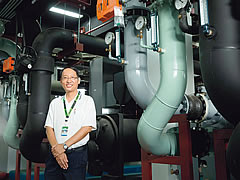
Mr. Arayasiri, in charge of the renovations, is shown with the building's new highly-efficient centralized air conditioning system.
Manaswee Arayasiri
Sanitary Engineer, Department of Public Works, BMA
"By replacing the outdated centralized air conditioning system with a modern one, our power consumption has dropped by 30%. We are now in a position to put to better use the different kinds of technology and know-how we learned from JICA and Yokohama City."

Sermsook Noppun (left), Head of the Climate Change Strategy Sub-Division , and Termsiri Chongpoonphol, Director of the Air Quality and Noise Management Division.
Sermsook Noppun
Head, Climate Change Strategy Sub-Division, BMA
"I attended a training course on climate change in Yokohama last year. I noted that many people use bicycles for transport, which helps reduce GHGs. The traffic signal system was also excellent and gave me some ideas to adopt in our own projects.
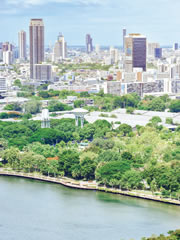
Urban greening, such as development of parks in the city center, is being promoted in Bangkok to make people's life comfortable and suppress the urban heat island effect.
Making the city disaster resilient
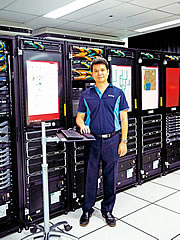
The Climate Change Data Center was established in Bangkok's Kasetsart University with the support of JICA. It collects a wide variety of real-time information throughout Thailand.
Chaiporn Jaikaeo
Assistant Professor, Kasetsart University
Leads a team developing a system for analyzing hydrological and meteorological data. "Images taken by the Japan Aerospace Exploration Agency (JAXA) using the weather satellite Himawari are sent to this server."
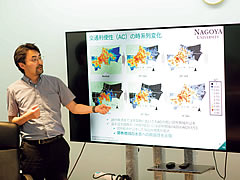
Shinichiro Nakamura, an Associate Professor at the Graduate School of Engineering of Nagoya University.
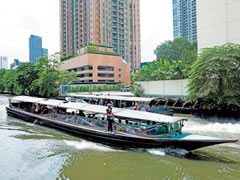
River taxis travel through Bangkok's waterways. Just like the railways, the boats are being further developed as a means of public transport.
Interview
Encouraging Motivation for Climate Actions
Panitnart Tanaapinan
Deputy Director General, Department of Environment, BMA
"Attending training in Japan and collaborating with JICA experts have increased everyone's motivation, allowing us to expand our knowledge and skills. JICA's important role is apparent in the fact that the Climate Change Strategy Sub-Division was established within the Department of Environment specifically to promote implementation of the Master Plan, and to strengthen BMA collaboration with concerned departments and bodies."





scroll